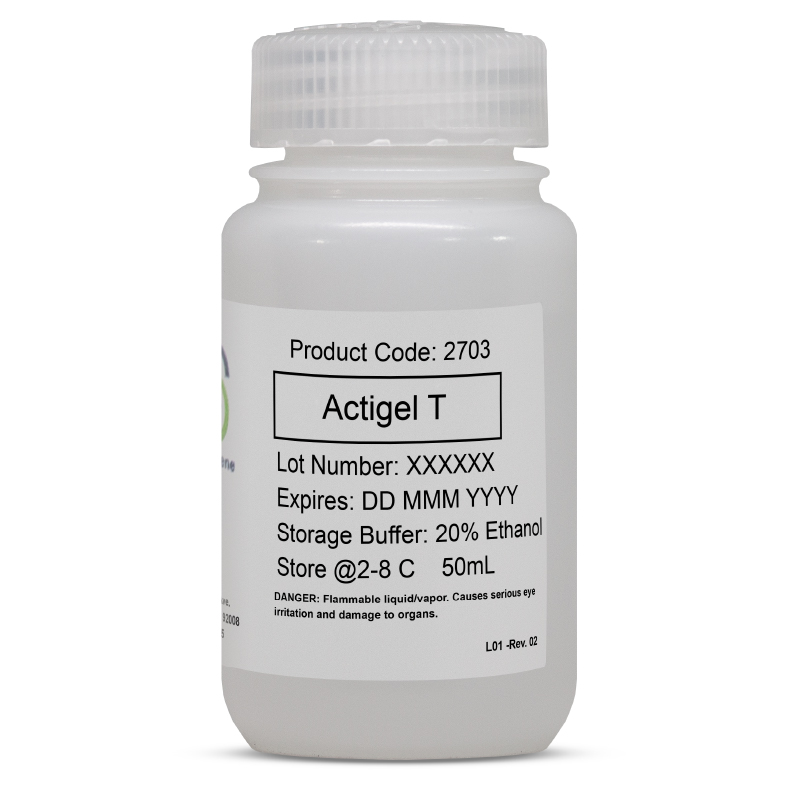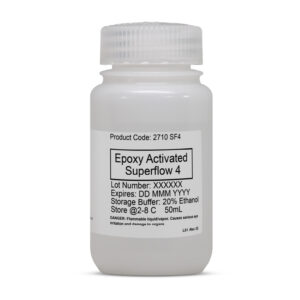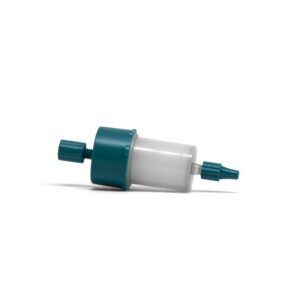Table 1. Resin Characteristics
| Bead Material
| Agarose |
| Bead Percentage
| 4% |
| Bead Size | 60-160 µm |
| Flow Rate1 | >25 mL/min (>850 cm/hr) @ 25oC |
| pH Stability2 | 2-8 |
| Storage Temperature | 2-8o C |
| Storage Buffer
| 20% Ethanol |
| Form | Slurry |
| Chemical Stability2 | Stable in all commonly used aqueous solutions and buffers. |
| Physical Stability2 | Negligible volume variation due to changes in pH or ionic strength. |
1Linear flow rate = volumetric flow rate (cm3/h)/column cross-sectional area (cm2)
2Data refer to the coupled product, provided that the ligand can withstand the pH or chemical environment. Please note the following: pH stability, long term refers to the pH interval where the medium is stable over a long period of time without adverse effects on its subsequent chromatographic performance. pH stability, short term refers to the pH interval for regeneration and cleaning procedures.
Instructions for Use
Actigel T resin is a free sulfhydryl-containing resin designed for affinity purification of thiol containing molecules or for immobilizing ligands by virtue of the sulfhydryl bond. Mixed disulfides are formed under mild conditions, and elution can be carefully controlled. Another use of Actigel T is to bind catalytic cysteines in enzymes to the resin. This is a useful strategy for protecting the sulfhydryl from oxidation during storage, thereby preserving enzyme activity.
When working with sulfhydryl groups, care must be taken to prevent oxidation. Two useful precautions are 1) include EDTA in all buffers to prevent metal – catalyzed oxidation, and 2) degas buffers to reduce the amount of dissolved oxygen. In addition, working at a pH < 8 is important for preserving the integrity of the ligand. It is also important to note that thiol exchange reactions are relatively slow, so binding or elution typically requires 30 minutes at room temperature or one hour at 4 °C.
The beads are shipped in 20% ethanol, but can be further sanitized with 70% ethanol, 8M urea, or 6M guanidine HCl. Phosphate buffers are used in the protocols below, but sodium acetate or Tris HCl are commonly used as well. Coupled resin can be stored in 0.1M sodium phosphate buffer, pH7.5, 5mM EDTA, 0.02% sodium azide (NaN3).
Note: Never let a hydrated agarose bead drop below 0 °C during storage because freezing has the effect of damaging the agarose structure causing the beads to fracture. This damage makes the resin unusable, and it should be discarded.
Ligand Immobilization:
1. Dissolve thiol-containing ligand in one bed volume (BV) of degassed 0.1 M sodium phosphate buffer (pH 7.5), 5 mM EDTA (binding buffer).
2. Wash storage buffer from uncoupled Actigel T with 5 BV of deionized (DI) water. Drain using a Buchner or sintered glass funnel, or in the column.
3. Combine equal volumes of ligand and washed Actigel T either in batch or on a column. Allow the thiol exchange to proceed 30-60 minutes.
4. Drain the buffer. Measure ligand concentration to determine percentage bound. Reapply if binding was inadequate and incubate an additional hour.
Elution:
1. Wash bound resin with binding buffer until baseline is stable.
2. Elute with 2 mercaptoethanol (typically 20-50 mM) or dithiothreitol (10-25 mM) in binding buffer. L-cysteine, reduced glutathione, or other sulfhydryl-containing reagents can also be used for elution.
3. If needed, perform buffer exchange with the eluent to remove free sulfhydryls.
Actigel T resin can be regenerated with DTT, mercaptoethylamine, or 2, 2- dipyridyl disulfide.
To Download Instructions for use:
INST 2703 Actigel T


